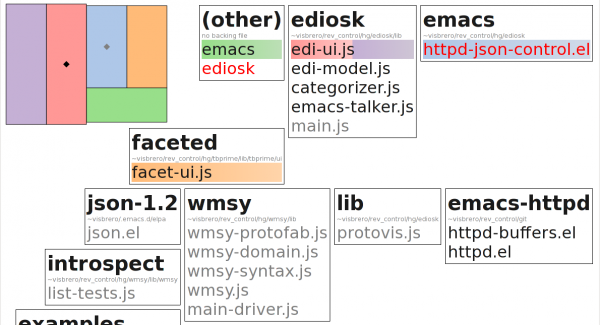Emacs users and would-be emacs users, are you tired of those emacs developers in their ivory towers not supporting buffer switching via touch-screen on a computer that’s not running emacs and using modern web browser technology instead of disproven parentheses-based technology? Be tired no more!*
Thanks to Christopher Wellons and Chunye Wang’s work on emacs-httpd it is a simple matter to expose a JSON representation of the current set of frames/windows/buffers in your emacs session and provide non-REST manipulation mechanisms via a webserver implemented in elisp.
Once you have exposed an API, it is a subsequent simple matter to implement some JavaScript that understands these things and presents a nice UI. In this case, we have used the Jetpack SDK, wmsy (the Widget Manifesting SYstem, an widgeting framework I am developing), and protovis.
The screenshot basically captures the entire feature-set:
- A protovis-based visualization that shows the location of all of the emacs “windows” (the things that show buffers). Emacs reports to us the pixel-space coordinates/sizes of the “frames” (GUI windows) and “windows”, so this all comes magically for free. The downside is your emacs windows need to be in the same coordinate space, so use of multiple X displays without use of DMX will likely lead to weird overlap.
- The selected “window” in each “frame” gets a diamond. The active frame’s diamond gets to be black instead of gray.
- Clicking on a “window” focuses/raises the containing “frame” and selects the “window”.
- Buffers grouped by the directory they live in (if they have a backing file).
- Buffers visible in windows have their background composed of the colors for all the windows they are in.
- Buffers that are modified have their text colored red.
- Buffers that have not been freshly displayed in a window recently have their text colored grey.
- Clicking on a buffer displays it in what the UI believes to be the currently selected frame’s currently selected window.
* This entire paragraph is a joke**; no flaming necessary.
** ediosk is not a joke though. I seriously have a touch-screen monitor hooked up to my windows build machine to the right of my two monitors hooked up to my linux/primary development machine. While c-x b (icicle mode) will still be my dominant buffer switching mechanism, I expect ediosk to prove useful/amusing for cases where the number of buffers greatly exceeds my mental stack, when I am switching contexts, or when I am working in multiple branches simultaneously.


Sounds like a good start toward “Buffer Candy”.